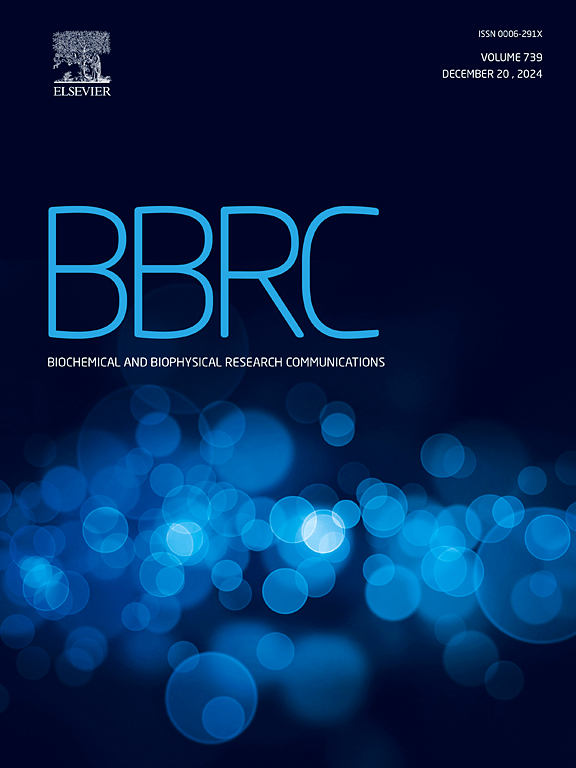Therapeutic effect and mechanism of far-red/near-infrared light on lens-induced myopia Guinea pigs
IF 2.5
3区 生物学
Q3 BIOCHEMISTRY & MOLECULAR BIOLOGY
Biochemical and biophysical research communications
Pub Date : 2025-07-01
DOI:10.1016/j.bbrc.2025.152282
引用次数: 0
Abstract
Purpose
In order to providing an experimental and theoretical bases for the clinical application of FR/NIR in myopia treatment, this work investigated the therapeutic efficacy and underlying mechanisms of far-red/near-infrared light (FR/NIR) intervention in lens-induced myopia (LIM) progression using a LIM guinea pig model.
Methods
In this study, 2-week-old healthy tricolor guinea pigs were randomly assigned to three groups: normal control (NC) group, LIM group and LIM treated with FR/NIR (LIM + FR/NIR) group. The guinea pigs in the LIM and LIM + FR/NIR groups wore a −6.00D lenses on the right eye to establish the LIM model. The guinea pigs in the LIM + FR/NIR group received FR/NIR treatment, while those in the NC group had no intervention. The right eyes were used to experimental study, and the experimental period was 3 weeks. Before and after the experiment, ocular parameters such as refractive status and axial length were measured. The related indexes of the retina and choroid were evaluated, and hematoxylin-eosin (HE) staining was performed to observe the changes in retinal morphological structure. Transcriptome sequencing, RT-qPCR, and immunofluorescence staining were employed to elucidate the cell and molecular mechanisms.
Results
After 3 weeks of intervention, the LIM group developed a relative myopia shift of −6.83D, significantly higher than the −3.66 D shift in the LIM + FR/NIR group. Compared with the NC group, significant changes were observed in multiple ocular parameters of the LIM group. However, the progression was attenuated by FR/NIR treatment. The LIM + FR/NIR group owned the increased retinal/choroidal thickness, the enhanced choroidal blood perfusion, and the preserved retinal morphological structure that resembles to physiological norms. The results of transcriptome sequencing and related testament indicated that FR/NIR could regulate the expression of photoreceptor-related genes and improve photoreceptor function.
Conclusion
FR/NIR can effectively suppresses myopia progression in LIM guinea pigs, maintain retinal/choroidal integrity, and ameliorate ischemic-hypoxic microenvironments. Its mechanism of action may involve regulating photoreceptor-related genes to improve photoreceptor function.
远红/近红外光对豚鼠晶状体性近视的治疗效果及机制
目的研究远红/近红外光(FR/NIR)干预晶状体性近视(LIM)进展的疗效及其机制,为FR/NIR在近视治疗中的临床应用提供实验和理论依据。方法将2周龄健康三色豚鼠随机分为正常对照(NC)组、LIM组和LIM加FR/NIR (LIM + FR/NIR)组。LIM组和LIM + FR/NIR组的豚鼠右眼配戴−6.00D透镜建立LIM模型。LIM + FR/NIR组豚鼠接受FR/NIR治疗,NC组不进行干预。采用右眼进行实验研究,实验周期为3周。实验前后分别测量屈光状态、眼轴长度等眼参数。评估视网膜及脉络膜相关指标,并用苏木精-伊红(HE)染色观察视网膜形态结构变化。利用转录组测序、RT-qPCR和免疫荧光染色来阐明细胞和分子机制。结果干预3周后,LIM组的相对近视位移为- 6.83 3d,显著高于LIM + FR/NIR组的- 3.66 D。与NC组比较,LIM组多个眼参数有明显变化。然而,FR/NIR治疗减缓了病情进展。LIM + FR/NIR组视网膜/脉络膜厚度增加,脉络膜血灌注增强,视网膜形态结构保持与生理规范相似。转录组测序和相关证据表明,FR/NIR可以调节光受体相关基因的表达,改善光受体功能。结论fr /NIR能有效抑制近视进展,维持视网膜/脉络膜完整性,改善缺血-缺氧微环境。其作用机制可能与调节光感受器相关基因以改善光感受器功能有关。
本文章由计算机程序翻译,如有差异,请以英文原文为准。
求助全文
约1分钟内获得全文
求助全文
来源期刊
CiteScore
6.10
自引率
0.00%
发文量
1400
审稿时长
14 days
期刊介绍:
Biochemical and Biophysical Research Communications is the premier international journal devoted to the very rapid dissemination of timely and significant experimental results in diverse fields of biological research. The development of the "Breakthroughs and Views" section brings the minireview format to the journal, and issues often contain collections of special interest manuscripts. BBRC is published weekly (52 issues/year).Research Areas now include: Biochemistry; biophysics; cell biology; developmental biology; immunology
; molecular biology; neurobiology; plant biology and proteomics

 求助内容:
求助内容: 应助结果提醒方式:
应助结果提醒方式:


